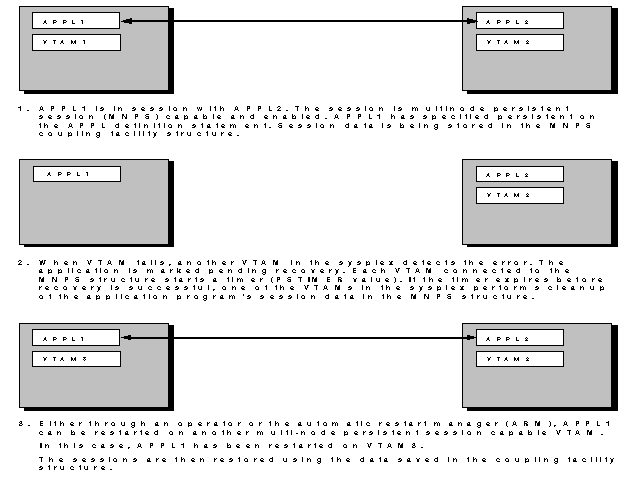 z/OS Communications Server: SNA Network Implementation Guide
z/OS Communications Server: SNA Network Implementation Guide
 z/OS Communications Server: SNA Network Implementation Guide
z/OS Communications Server: SNA Network Implementation Guide
|
Previous topic |
Next topic |
Contents |
Contact z/OS |
Library |
PDF
Multinode persistent sessions z/OS Communications Server: SNA Network Implementation Guide SC27-3672-01 |
|
|
VTAM® uses the coupling facility
in the MVS™ sysplex to maintain
session and HPR connection information for all multinode persistent
session (MNPS) application programs. This allows VTAM to restore application sessions after instances
of system or application failure, or as part of takeover of the application.
Applications capable of using triple-DES encryption lose the triple-DES sessions if the application is moved to a node running a level of Communications Server for OS/390® that does not support triple-DES sessions. Also, if the application requires triple-DES encryption (ENCRTYPE = TDES24 was coded on the definition statement), the application is not allowed to successfully issue OPEN ACB on a node running a level of Communications Server for OS/390 that does not support triple-DES. Until the application program is restarted, incoming data is maintained at the other end of the HPR connection. When the application is restarted and before the sessions are restored, VTAM stores the incoming data. VTAM uses Control Vector 29 to preserve the session state. This includes the last sequence number, RH, and the first five bytes of the RU for each expedited and normal PIU sent outbound and inbound. At restart, VTAM passes that information to the application to resynchronize with the session partner. It is recommended that you check your application to verify that it makes use of this information. The backup of a multinode persistence-enabled application program is shown in Figure 1. Figure 1. Application program backup
using multinode persistent sessions
 Multinode persistent session support is enabled if single node persistence has been enabled, PERSIST=MULTI has been specified, and the configuration requirements are met. Using the PERSIST operand on the APPL definition statement, you can make an application program multinode persistence-capable (however, single node persistence is always available). To change an application program from multinode persistence to single node persistence (and vice versa) you must first close and deactivate the application, modify the APPL definition statement (PERSIST operand), reactivate the application program major node, and start the application program. When operating on a network node, use a model definition for your MNPS applications, because PERSIST=MULTI cannot be coded on a nonmodel application definition if VTAM is a network node. MNPS forced takeover processing requires some additional settings at the taking over application to indicate that this is a forced takeover attempt. In particular, PARMS=(FORCETKO=YES) must be coded on the ACB macroinstruction. Similarly, additional action is required at the application being taken over to indicate that forced takeovers are acceptable. In particular, PARMS=(FORCETKO=ALL) or PARMS=(FORCETKO=MULTI) must be coded on a SETLOGON OPTCD=PERSIST macroinstruction. 


|
 Copyright IBM Corporation 1990, 2014 Copyright IBM Corporation 1990, 2014 |